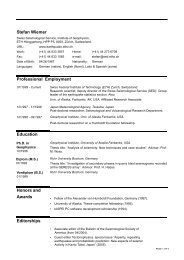zmap a tool for analyses of seismicity patterns typical applications ...
zmap a tool for analyses of seismicity patterns typical applications ...
zmap a tool for analyses of seismicity patterns typical applications ...
You also want an ePaper? Increase the reach of your titles
YUMPU automatically turns print PDFs into web optimized ePapers that Google loves.
Narrowing the target <strong>of</strong> investigation: At this point one might decide to study just the<br />
shallow <strong>seismicity</strong>. Because <strong>of</strong> the minimum <strong>of</strong> the numbers at 35 km depth (Figure 5),<br />
this <strong>of</strong>fers itself as the natural cut. The bulk Mc <strong>for</strong> the shallow events can be estimated<br />
by the same steps as outlined above. It turns out to be 1.9. There<strong>for</strong>e, you may want to<br />
map the Mc <strong>for</strong> the shallow <strong>seismicity</strong> with a catalog without the events below M1.5,<br />
because we know that not enough parts <strong>of</strong> the catalog can be complete at that level. The<br />
catalog <strong>for</strong> the period and area with depths shallower than 35 km and M>1.4 contains<br />
15078 events. The map <strong>of</strong> Mc (Figure 9) is obtained by selecting Calculating Mc and b-<br />
Figure 9: Map <strong>of</strong> magnitude <strong>of</strong> complete reporting.<br />
value Map from the Mapping b-values menu in the ZTools menu <strong>of</strong> the <strong>seismicity</strong> map.<br />
The cross hairs that appear are used to click by left mouse button the polygon apexes<br />
desired, and terminating the process by clicking the right mouse button. Once the<br />
computation is completed, you can save the resulting grid (which also contains the<br />
catalog used) <strong>for</strong> reloading later on. Pressing Cancel will just move on without saving.<br />
It might be fun to interpret the b-value map that is presented at first after the calculation,<br />
but first we should examine the Mc map. We call <strong>for</strong> it by selecting mag <strong>of</strong><br />
completeness map in the menu <strong>of</strong> Maps in the <strong>seismicity</strong> window (Figure 9). Here the<br />
symbols <strong>for</strong> the epicenters are selected as none, such that they do not interfere with the<br />
in<strong>for</strong>mation on Mc.). In it, we see that the <strong>of</strong>fshore catalog is inferior since Mc>3.5.<br />
Be<strong>for</strong>e we accept the Mc map, it is a good idea to sample a number <strong>of</strong> locations to see if<br />
we agree with the algorithm’s choice <strong>of</strong> Mc by visual inspection <strong>of</strong> the FMD plots. For<br />
9



